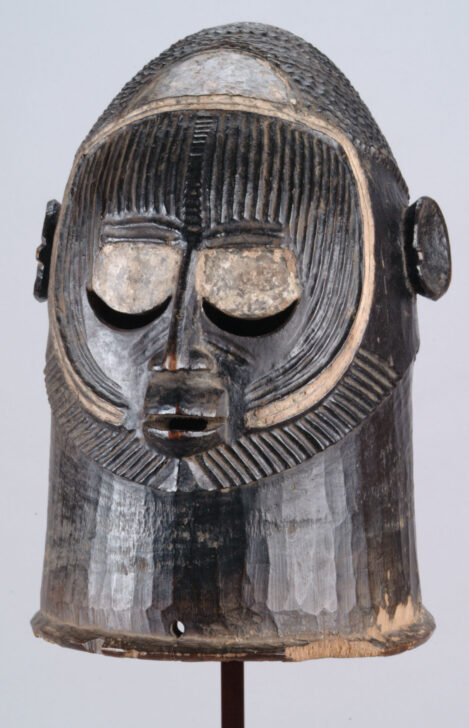Helmet Mask
Igala

Description
Subject Matter:
While some Igala masks refer to the ancestors of a local community, other masks, such as this one, haven been used in central, public masquerades that aim to represent the diverse yet shared identity among Igala peoples. Masks similar to this one, often called odumado, have been used in masquerades called Egwu-Ata, one of the most important annual events. As these masks are used to bring the Igala nation together, they fall under the control of the ruler, called the Ata. Different masks are cared for and performed by the clan or group they are associated with, which can be seen in the facial markings unique to each mask. Odumado masks, such as this one, are related to the Akpoto population of Igala peoples. Similar masks called agba are also found in the Ibaji region of Igala peoples. Although stylistically similar to odumado masks, agba masks have been used at funerals and festivals to celebrate the founders of local lineage groups.
References Cited:
Berns, Marla C., Richard Fardon and Sidney Littlefield Kasfir, eds. 2011. Central Nigeria Unmasked: Arts of the Benue River Valley. Los Angeles: UCLA Fowler Museum of Cultural History.
Cole, Herbert M. 2012. Invention and Tradition: The Art of Southeastern Nigeria. Munich: Prestel.
Smithsonian Institution. 1999. Selected Works from the Collection of the National Museum of African Art, Volume I. Washington, D.C.: National Museum of African Art, Smithsonian Institution.
Physical Description:
Dark colored mask with an ovoid shaped head. The face has incised parallel striations, round white eyes with open crescents below, round ears, a small nose and a small mouth. The coiffure is composed of parallel ridges circumventing the entire head. There are two holes around the bottom edge of the mask, one in the front and one in the back.
Usage Rights:
If you are interested in using an image for a publication, please visit https://umma.umich.edu/request-image/ for more information and to fill out the online Image Rights and Reproductions Request Form.